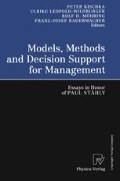Abstract
Environmental planning and cost-benefit modeling in crime control shows some striking analogies. The purpose of this note is to exploit this fact in an intertemporal framework. In particular, the optimal mix of ‘prevention’ and ‘treatment’ in pollution control and illicit drug consumption is illustrated by several optimal control and dynamic game models.
Access this chapter
Tax calculation will be finalised at checkout
Purchases are for personal use only
Preview
Unable to display preview. Download preview PDF.
References
Borisov, V., Feichtinger, G. Kryazhimskii, A. (1998): Optimal enforcement on a pure seller’s market of illicit drugs. Forschungsbericht 224 des Instituts fir Ökonometrie, OR und Systemtheorie, TU Wien
Barrett, J., Segerson, K. (1997): Prevention and treatment in environmental policy design. Journal of Environmental Economics and Management 33, 196–213
Becker, G.S. (1968): Crime and punishment: an economic approach. Journal of Political Economy 76, 169–217
Behrens, D., Caulkins, J.P., Tragler, G., Feichtinger G. (1997): Controlling the US cocaine epidemic: Finding the optimal mix of drug prevention and treatment. Forschungsbericht 214 des Instituts fir Ökonometrie, OR und Systemtheorie, TU Wien
Clark, C.W. (1976): Mathematical Bioeconomics. The Optimal Management of Renewable Resources. Wiley, New York
Clark, C.W. (1985): Bioeconomic Modelling and Fisheries Management. Wiley, New York
Caulkins, J.P. (1993), Local drug markets’ response to focused police enforcement. Operations Research 41, 848–863
Caulkins, J.P., Tragler, G., Feichtinger G. (1998): Addiction is like a switch. Working Draft, Vienna University of Technology
Dasgupta, P.S., Heal, G.M. (1979): Economic Theory and Exhaustible Resources. J. Nisbett, Welwyn, Cambridge, Univ. Press
Dockner, E.J., Feichtinger G., Jorgensen, S. (1985): Tractable classes of nonzero-sum open-loop Nash differential games: theory and examples. Journal of Optimization Theory and Applications 45, 179–197
Dockner, E.J., Long, Ngo Van (1993): International pollution control: cooperative versus non-cooperative strategies. Journal of Environmental Economics and Management 25, 13–29
Feichtinger, G. (1983): A differential games solution to a model of competition between a thief and the police. Management Science 29, 686–699
Feichtinger, G. (1984): On the synergistic influence of two control variables on the state of nonlinear optimal control models. Journal of Operational Research Society 35, 907–914
Feichtinger, G., Hartl, R.F. (1986): Optimale Kontrolle ökonomischer Prozesse: Anwendungen des Maximumprinzips in den Wirtschaftswissenschaften. de Gruyter, Berlin
Feichtinger, G., Grienauer, W., Tragler, G. (1997): Optimal dynamic law enforcement. Forschungsbericht 197 des Instituts für Ökonometrie, OR und Systemtheorie, TU Wien
Feichtinger, G. (1998): Dynamic economic models of optimal law enforcement. Forschungsbericht 200 des Instituts für Ökonometrie, OR und Systemtheorie, TU Wien
Forster, B.A. (1977), One a state variable optimal control problem: consumption-pollution trade-offs. In: Pitchford, J.D., Turnovsky, S.J. (Eds.): Applications of Control Theory to Economic Analysis. North-Holland, Amsterdam, 35–56
Hofbauer, J. and K. Sigmund, 1998, Evolutionary Games and Population Dynamics, Cambridge University Press, Cambridge
Kamien, M.I., Schwartz, N.L. (1971a): Optimal maintenance and sale age for a machine subject to failure. Management Science 17, B495–B504
Kamien, M.I., Schwartz, N.L. (1971b): Limit pricing and uncertain entry. Econometrica 39, 441–454
Kamien, M.I., Schwartz, N.L. (1981): Dynamic Optimization: The Calculus of Variations and Optimal Control in Economics and Management. North-Holland, New York
Kort, P., Feichtinger, G., Hartl, R.F., Haunschmied J.L. (1998): Optimal enforcement policies (crackdowns) on a illicit drug market. Optimal Control Applications and Methods 19, 169–184
Lilien, G.L., Kotler, P. (1983): Marketing Decision Making: A Model-Building Approach. Harper & Row, New York
Leonard, D., Long, N.V. (1992): Optimal control theory and static optimization in economics. Cambridge University Press, Cambridge
Rydell, C.P. (1997): The dynamics of cocaine control policy analysis based on exploratory modeling. Working paper
Rydell, C.P., Caulkins, J.P., Everingham, S.S. (1996): Enforcement or treatment? Modeling the relative efficacy of alternatives for controlling cocaine. Operations Research 44, 1–9
Rydell, C.P., and Everingham, S.S. (1994): Controlling cocaine. Supply versus demand programs. MR-331-ONDCP/A/DPRC, Santa Monica, Rand, CA
Sethi, S.P. (1979): Optimal pilfering policies for dynamic continuous thieves. Management Science 25, 535–542
Shavell, S. (1983): Torts in which victim and injurer act sequentially. Journal of Law Economics 26, 598–612
Tahvonen, O., Withagen, C. (1996): Optimality of irreversible pollution accumulation. Journal of Economic Dynamics and Control 20, 1775–1795
Tragler, G., Caulkins, J.P., Feichtinger, G. (1997): Optimal dynamic allocation of treatment and enforcement in illicit drug control. Forschungsbericht 212 des Instituts für Ökonometrie, OR und Systemtheorie, TU Wien
Wirl, F. (1998): Complex dynamic environmental policies. Forthcoming in Resource and Energy Economics
Author information
Authors and Affiliations
Editor information
Editors and Affiliations
Rights and permissions
Copyright information
© 2001 Springer-Verlag Berlin Heidelberg
About this chapter
Cite this chapter
Feichtinger, G. (2001). Environmental Policy Design and the Economics of Crime: Some Analogies in Intertemporal Optimization. In: Kischka, P., Möhring, R.H., Leopold-Wildburger, U., Radermacher, FJ. (eds) Models, Methods and Decision Support for Management. Physica, Heidelberg. https://doi.org/10.1007/978-3-642-57603-4_2
Download citation
DOI: https://doi.org/10.1007/978-3-642-57603-4_2
Publisher Name: Physica, Heidelberg
Print ISBN: 978-3-642-63306-5
Online ISBN: 978-3-642-57603-4
eBook Packages: Springer Book Archive

